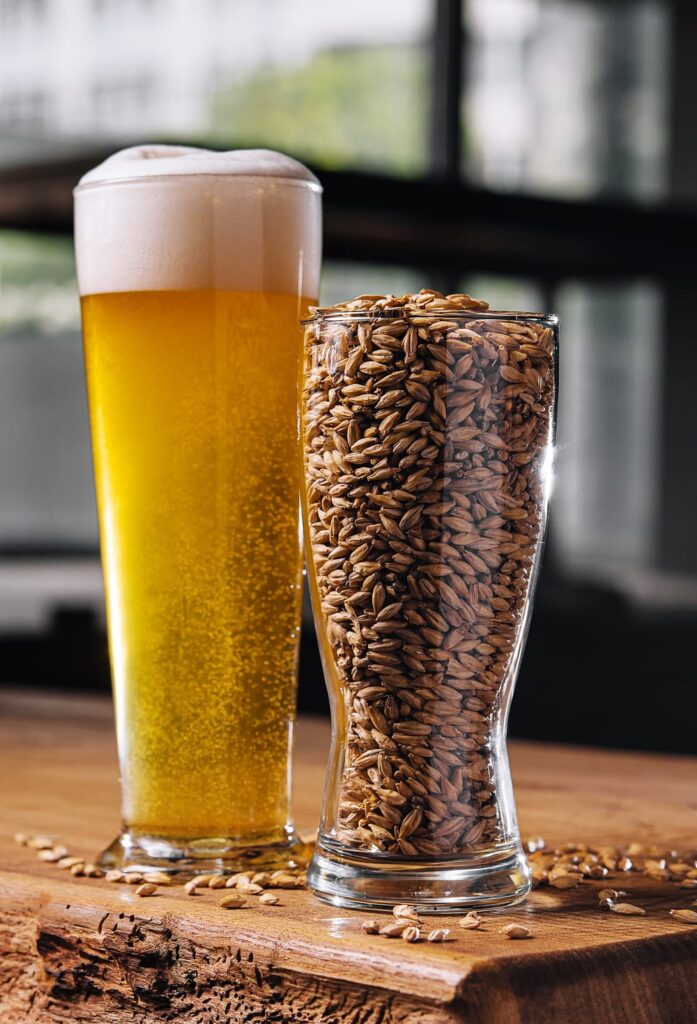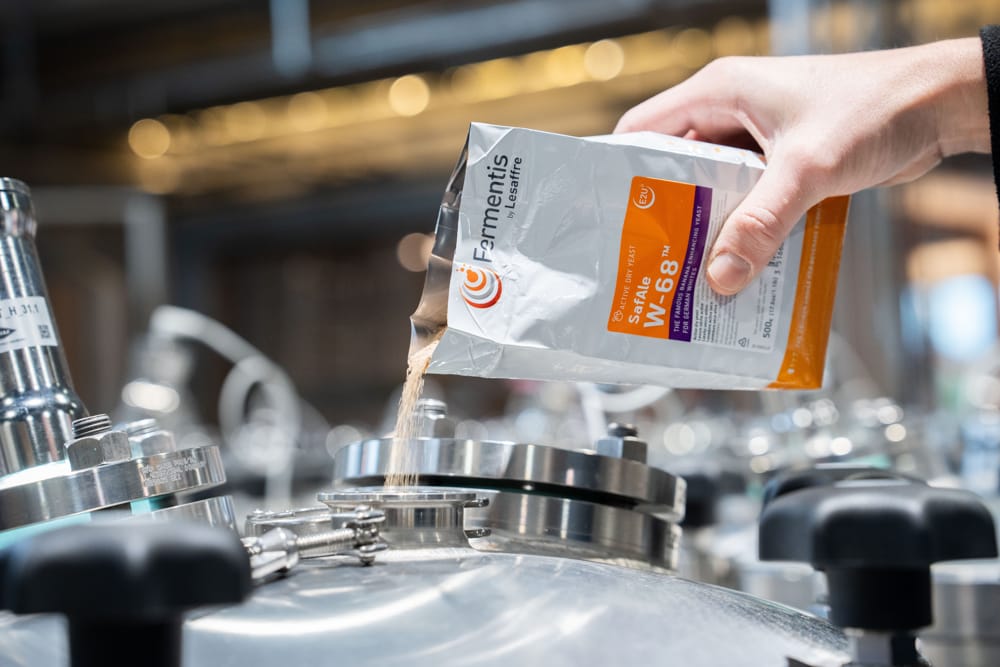Weissbier, the traditional German wheat beer
The German wheat beer style includes various types of beer, one of the most well-known being Weissbier – also know as Weizen or Hefeweizen. Particularly popular in southern German, this beer style is described by the Brewers Association beer style guidelines as often being cloudy in appearance, with hallmark fruity and phenolic attributes. Banana ester aroma flavor should be present, while perceived malt and hop aroma and flavor is generally very low. Its distinctive banana and clove flavors and high carbonation contribute to making Weissbier a refreshing drink. Lower-alcohol and even non-alcoholic versions are also available and very popular alternatives.
Let’s have a closer look at this specific beer style.

Weissbier: general characteristics
A little history on German Weiss beer
German wheat beers have a long history. In Bavaria for instance, the wheat beer tradition seems to date back from the 14th century. At the time, brewing wheat beer was reserved for Bavarian royalty. Indeed, a royal license had to be obtained to be allowed to brew this particularly popular drink. The system remained unchanged for two centuries until the popularity of Weissbier started to decline resulting in many breweries closing. This led the crown to relinquish the control of the production, leading to the reopening of the brewing of Weissbier to the public.
As a result, many breweries in Germany began to brew wheat ales again, alongside the lagers they were already producing. But one man played a key role in renewing the popularity of Weissbier: Georg Schneider. After purchasing an old brewery in Munich, he started to produce bigger outputs and to experiment, creating the amber version of Weissbier in 1872. His brewery is still in activity today and still run by the Schneider family. The paler version of Weissbier has only become popular since the 1960s, and the drink is to this day very much appreciated in southern Germany.
Beer appearance and ideal tasting conditions
According to the Brewers Association, Weissbier tends to have a medium to full body, with a characteristically fuller, creamier mouthfeel. Ranging from straw to amber in color, German wheat beers can be hazy or cloudy due to the presence of wheat and yeast. This haziness can, however, settle out in bottles. These beers are preferably enjoyed while young and fresh. They are served in tall Weizen glasses that improve aeration and support the foam while also showing off this style’s renowned hazy, golden color.
With its high carbonation and dry finish, a Weissbier is the perfect refreshing drink. As far as food pairing is concerned, the light alcohol degree and distinctive banana and clove flavors make it an ideal drink to have with a salad, seafood dishes or even banana puddings among others. Be creative and explore the originality of the beer by associating it with original dishes.
Weissbier flavor and mouthfeel
Weissbier has a unique style and flavor. The distinctive and often well-balanced banana and clove aromas contribute to making it an original drink. Besides these typical flavor characteristics, it’s worth mentioning a light to moderate grainy wheat flavor and light vanilla flavor.
Bitterness tends to be very low, with a well-rounded palate and a dry finish. With a medium-light to medium body, Weissbier is never too heavy. The mouthfeel is fluffy and creamy and always effervescent due to the very high carbonation of the brewing process. All in all, an ideal refreshing drink.

The crafting of Weissbier
Brewing ingredients
Recipes to craft a German wheat beer vary depending on what style you wish to brew, Hefeweizen, Dunkelweizen or Kristalweizen for example. Nevertheless, one ingredient remains unchanged – the wheat, of course! According to German law, any beer that uses the name Weissbier or Weizen must contain at least 50 percent of malted wheat. The 50 percent remaining needs to be made up of light or dark-colored malts.
As a slightly hoppy beer, traditional German wheat beers generally use German varieties, such as Hallertau, Spalt, Tettnang, Perle or sometimes Saaz being popular choices for this style of beer. Whichever one you choose, always make sure to use it lightly so as not to balance out the beer’s sweetness and strong yeast flavors, which are hallmarks of this style.
Fermentation and yeast
In wheat beer styles such as Hefeweizen and Dunkelweizen, which are traditionally unfiltered, yeast and its fermentative aromas play a crucial role in defining the beer’s distinctive character. The specific strains of yeast used in these styles contribute to the signature fruity and spicy flavors, with banana and clove being the most prominent aromas. These fermentative by-products, primarily esters and phenols, are produced during fermentation and are essential to the beer’s identity, often being by far more pronounced than hop flavors and bitterness.
The yeast’s interaction with the malted wheat and barley further enhances the beer’s smooth mouthfeel and creamy texture, making yeast management and fermentation temperature control vital to achieving the perfect balance of these unique flavors.
In this particular style of beer, the use of the appropriate yeast is also key. Weissbier uses top-fermenting Weizen yeast and no other, so it’s essential that you select an appropriate strain to respect the style. Note that non-alcoholic versions of the drink can also be brewed.

Yeast suggestions for brewing the perfect German Weissbier
For the brewing of a typical German Weiss or Weizen, we recommend the use of the following yeasts:
SafAle™ W-68
A historical yeast for German-style wheat beers, SafAle™ W-68 was selected to produce aromatic beers with typical phenolic character and prominent banana and tutti-frutti notes. This specialty yeast is suitable for a wide variety of wheat-base beers and fruity-spicy oriented styles. With a medium sedimentation, it forms a powdery haze when resuspended in the beer.
SafAle™ WB‑06
The perfect solution for wheat base beers, this versatile brewer’s yeast provides fruity and phenolic character, varying with the fermentation conditions. SafAle™ WB-06 produces well-attenuated beers and is ideal for both German and Belgian wheat beer styles. This yeast produces phenolic notes typical of wheat beers and allows to brew beer with a high drinkability profile.
Our yeast recommendations are meant solely as a guide to help you choose the right strain from our range. It is entirely possible to brew a specific style of beer with a different strain: feel free to experiment and be creative!
At Fermentis, we are committed to finding the best beer yeast for brewing. Thanks to our talented teams, we have created innovative brewing yeast solutions such as active dry yeast. Using dry yeast improves the stability and shelf-life of the beer. But not only! Check out the benefits of using active dry yeast for brewing on our website.
Factsheet
Weiss Beer
The German wheat beer
Origins: Germany
Color: pale straw to deep yellow
Bitterness: low to medium-low
Alcohol: low
Mains flavors: banana and clove, hoppy with no bitterness
IBU: 8-15

